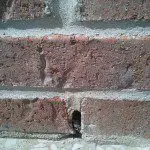24 May 2013
No Weep Holes and Other Chicago Masonry Problems

Weep holes like this allow moisture to escape the brick, preventing mold and other moisture problems.
If you see a hole or holes along the bottom of a brick wall, don’t worry. They are most likely weep holes, and there is a reason for them to be there. If they aren’t there, you have reason for concern. Weep holes ventilate the narrow cavity between the brick and the interior wall. Without weep holes, moisture that wicks through the brick and mortar will soak into the framing and drywall, making them magnets for termites and mold. But any water that comes in through the weeps will hit metal flashing, if the inside walls were built properly.
Most building inspectors will notice the problem. Other problems that frequently occur in Chicago masonry buildings are:
- Lack of flashing. Weep holes won’t work without it.
- Poor pointing. There should not be gaps in the mortar.
- Unpainted lintels over doors and windows. The steel lintels eventually will rust, causing expansion that will crack the adjoining block.
- Stone window sills that are level or sloped back toward the window, instead of sloping away from the window to keep the water out.
- Poorly sealed stress and expansion joints.
If you see any of these problems, call a trusted masonry contractor such as Shamrock Tuckpointing for an inspection. Left unattended small problems can escalate into major repairs.


